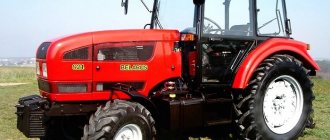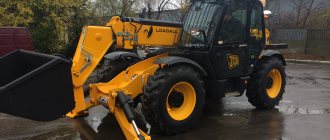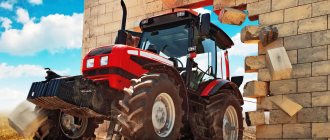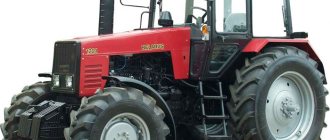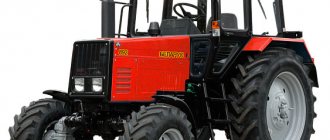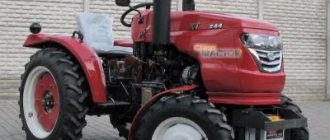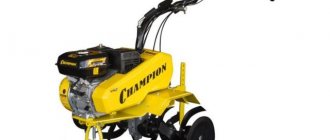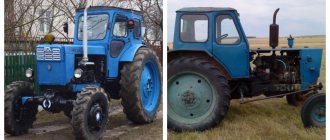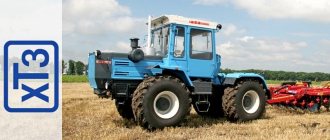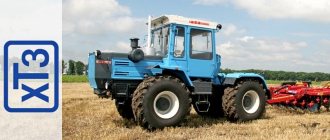Minsk Tractor Plant, established in 1946, is one of the ten leading manufacturers of wheeled agricultural machinery. The first mass model was the MTZ-5, produced in more than 644 thousand copies. MTZ models were distinguished by their design, adapted for operation in various climatic zones. The versatility and reliability of tractor components allow the plant to hold up to 10% of the world market for wheeled agricultural machines.
The lineup
The MTZ plant offers customers wheeled and tracked tractors, special equipment based on them, as well as forestry machines. Belarus tractor models are equipped with diesel engines of our own production. A number of models are equipped with imported power plants from Lombardini, Caterpillar, etc. The latest tractor models are equipped with imported components and components, which made it possible to extend the warranty period to 5 years. New tractors are equipped with sealed cabins with microclimate systems, which improves the operator’s working conditions.
KT-12 and KT-12A
0
Source:
In the spring of 1951, the MTZ team received a very important government task - to master the production of skidders, which were in great demand in the logging industry. The KT-12 gas generator tractor is a special tracked vehicle designed for forest skidding. It appeared in the USSR in the first post-war years. There were no analogues to it in any country in the world. Previously, skidding was carried out by horse-drawn vehicles, manual or mechanical winches. The KT-12 tractor was created by designers of the Kirov plant in Leningrad in collaboration with scientists from the Leningrad Forestry Academy. The KT-12 tractor was produced at the Kirov plant until 1951. Now it was necessary to establish its production at the Minsk Tractor Plant. Only three months were allotted to resolve all organizational issues. So, in the short history of its existence, MTZ had to develop a second (after the KD-35) machine, and, moreover, not of its own design. On August 15, 1951, the first batch of KT-12 skidding machines rolled off the main conveyor of the tractor assembly shop. During the production process, the tractor underwent modernization aimed at improving the performance of the machine. In a short period of time, factory designers, by changing a number of components and parts, increased the warranty period of the machine by 1.5 times.
MTZ-2
A general-purpose wheeled vehicle, produced in parallel in Minsk and Dnepropetrovsk. The tractor was developed at the MTZ design bureau in the early 50s of the last century. The machine became the first domestic universal pneumatic tractor. At the same time, the MTZ-1 version was produced, equipped with a reduced front wheel track. The tractor was used to work with plants with tall stems (for example, sunflowers). Both modifications belonged to the category of machines with a thrust of 1.4 tons.
The power plant of the vehicles consisted of a 2-cylinder diesel engine that developed a power of 37 hp. With. The engine was started by a 10 hp gasoline starting unit. With. The motor worked in conjunction with a 5-speed manual gearbox. Additionally there was 1 reverse gear. The box included a power take-off shaft (PTO) located on the rear cover. Additionally, there was a side shaft equipped with a pulley. It was used when operating a tractor with stationary equipment: water pumps, threshers, generators.
The axle suspension is rigid, with the ability to change the track. Changing the direction of movement was carried out by the front wheels, the steering was of a mechanical type. The open operator's station is located between the protective covers of the rear wheels. The tractor remained on the assembly line until 1958. The reasons for the removal of machines from steel production are: low speed, high fuel consumption and increased metal consumption of the structure.
MTZ is 75 years old: we remembered how the history of Belarus tractors began
MTZ celebrates its 75th anniversary: on May 29, 1946, the USSR Council of Ministers decided to build a tractor plant in the capital of the Belarusian SSR.
Today MTZ is the leader in the global tractor industry and the flagship of the domestic industry. The company produces more than a hundred models of tractors under the BELARUS brand for all climatic and operating conditions. The number of tractors manufactured at MTZ is approaching 4 million. On the eve of the company’s birthday, we decided to remember where the history of Belarus tractors began.
Initially, the Minsk Tractor Plant was created to produce medium-power row-crop crawler tractors of the Kirovets D-35 (KD-35) type.
Row-crop crawler tractor "Kirovets" D-35
Work on this machine in the USSR began back in the 1930s at the Kirov plant in Leningrad; the prototype for it was the American Caterpillar R2 tractor. The implementation of the project was prevented by the Great Patriotic War, but already in 1943, work on the new tracked vehicle resumed: the development of design documentation was continued by specialists from NATI (then the Scientific Automotive and Tractor Institute), and Lipetsk was chosen as the place of production of the tractor, where a new tractor plant was organized at the facilities. Serial production of tracked Kirov vehicles with a diesel engine began there in 1947.
Row-crop crawler tractor "Kirovets" D-35. Photo techstory.ru
However, the country needed a lot of tractors, so the Minsk Tractor Plant, which was under construction, also received the task of producing the KD-35. The project included the production of up to 50 tracked tractors per day. The plant also had to organize the production of diesel (D-35) and starting (PD-10) engines. Production was mastered step by step during the construction of the enterprise. In November 1950, Minsk residents began to assemble tracked “plowmen”.
True, the KD-35 was produced in Minsk for a short time - until August 1951, after which its production was transferred to Brasov, Romania. 406 tracked tractors were assembled at MTZ in 9 months.
Photo from the Scientific and Technical Museum of the History of Tractors
At the same time, MTZ began producing skidders for the forestry industry, transferred to Minsk from the Kirov plant. In 1951, production of the KT-12A model with a 36-horsepower UralZIS-352T gas generator engine began (the first batch of vehicles was assembled in August). In 1956, the TDT-40 diesel “skidder” was equipped, which was equipped with a 40-horsepower D-40T engine and could remove up to 5 cubic meters of wood from the cutting area in one trip. Even more advanced skidding machines were also developed in Minsk - TDT-54 and TDT-60.
Skidder tractor KT-12. Photo techstory.ru
The production of D-35 diesel engines and launchers did not stop in Minsk - they were supplied to the Lipetsk Tractor Plant to equip the KD-35/KDP-35 models, and were also installed on the first MTZ-1/MTZ-2 wheeled tractors.
The “wheeled” theme in Minsk arose in May 1948, when the plant was instructed, in parallel with the development of the production of tracked KD-35, to design a universal wheeled tractor with a 37-horsepower diesel engine and a hydraulic attachment system, allowing for the first time in the USSR to do without a trailer.
In October 1948, the preliminary technical design of the tractor was completed in two modifications: MTZ-2 - for inter-row cultivation of low-stem crops with matching tracks of the front and rear wheels; MTZ-1 – for processing tall crops with close front wheels.
In July 1949, the first prototype of a wheeled tractor emerged from the gates of the experimental workshop, which became the basis for the creation of a production machine. In addition to this, six more prototypes were produced, all of which went for long-term factory tests. Even then, at the suggestion of the chief designer of MTZ Ivan Iosifovich Drong (worked in Minsk in 1949-1963), the family of wheeled tractors received the name “Belarus”.
It was planned to launch mass production of wheeled tractors at the plant in July 1953, but the start of production was delayed for various reasons. And finally, on October 14, the first production tractor “Belarus” MTZ-2 of traction class 1.4 rolled off the main conveyor of tractor assembly shop No. 2.
The first serial MTZ-2
The first MTZ wheeled tractors. Photo by Alexander Ditlov
Constructed according to the “classical” design, the first Minsk “wheeler” was equipped with a four-stroke four-cylinder diesel engine D-36 produced by MTZ (it differed from the D-35 in a lightweight radiator and oil pan). Here are the main characteristics of this engine: displacement – 4.08 liters; rated power - 37 hp. at 1400 rpm; highest torque – 23 kgf m (225.6 N m) at 900 rpm.
MTZ-2 produced in 1953 from the collection of the factory museum. Serial number 10
The main diesel engine was started by a PD-10 starting engine (carburetor, two-stroke, single-cylinder, 10 hp). The gearbox on the MTZ-2 was a mechanical 5-speed (the number of forward gears is 5, reverse gears are 1). Travel speeds (calculated): in first gear – 4.56 km/h; in fifth – 12.95 km/h.
The tractor driver's workplace on the MTZ-2 was distinguished by its Spartan simplicity. The cabin was not provided at all. A tool box was installed above the fuel tank in special guides welded to the wings, which served as the frame for a double seat. The steering wheel is on the right side. Control and measuring instruments - oil and water thermometers and oil pressure gauges (one shows the pressure in the oil line, the second - after the fine filter).
The MTZ-2 tractor had a power take-off shaft (PTO) with a dependent drive from the intermediate shaft of the gearbox. The number of revolutions per minute of the PTO is 520. To work with stationary machines, a drive pulley was provided (its diameter is 320 mm; width is 200 mm; number of revolutions per minute is 828) driven by the PTO.
The weight of the unfuelled tractor was 3250 kg. The wheelbase of the MTZ-2 tractor was 2380 mm. Length – 3678 mm. Width (at the protruding ends of the rear wheel axle shafts) – 1884 mm. Height (along the steering wheel) – 1900 mm. Ground clearance: under the rear axle – 440 mm; under the front axle – 525 mm. The smallest turning radius is 3.7 m.
MTZ-2 was aggregated with almost two dozen agricultural machines and implements. It could be used to perform work on the care and harvesting of row crops, plowing light soils, pre-sowing treatment, sowing and harvesting grain crops, as well as for driving stationary agricultural machines and as a vehicle.
MTZ-2 went down in history as the first mass-produced domestic wheeled universal row-crop tractor with pneumatic tires. This model was also produced at the Southern Machine-Building Plant in Dnepropetrovsk (1954-1958). A total of 148,800 Belarus MTZ-2 tractors were manufactured.
After the first significant modernization, completed in 1957, the Belarus tractor began to be produced under the symbol MTZ-5. This model was distinguished by the use of a more powerful 40-horsepower D-40K engine, a 10-speed gearbox (which made it possible to expand the speed range from 0.82 to 20.75 km/h), a double clutch and an independent power take-off shaft (PTO) drive ), the presence of two remote cylinders and a three-spool distributor. The power of the generator used for lighting was 180 W and was sufficient to power four tractor headlights and two headlights of a trailed agricultural machine. The front wheels have become wider (tire size 6.50-16). The weight of the unfuelled tractor decreased from 3250 to 2850 kg.
In 1957, a modification of the MTZ-5K with a separate hydraulic system was produced for several months. Since 1958, the production of MTZ-5L and MTZ-5M tractors began with 45-horsepower D-40L/40M engines and starting, respectively, using a PD-10M starting engine and an electric starter.
Since 1960, tractors of new modifications MTZ-5LS and MTZ-5MS began to roll off the assembly line, which were equipped with 48-horsepower diesel engines D-48L/48M and were designed to perform various agricultural work at high speeds. For the first time, these tractors featured a removable closed cab, which could easily be converted into a semi-open or open cab with an awning. Transport speed increased to 22 km/h.
MTZ-7MS from the collection of the factory museum. Serial number 162035
At the end of the 1950s, the first Belarus tractor with all-wheel drive was created on the basis of the “five” in Minsk. This model received the MTZ-7 index. The new all-wheel drive tractor had increased traction and traction properties and high maneuverability, which made it possible to expand the scope of use of “wheeled vehicles” in agriculture and in some places even replace tracked vehicles with them.
On the MTZ-7, the drive to the front drive axle (which, by the way, used a number of components of the front axle of the GAZ-63 truck) was carried out by a driveshaft through a constantly engaged friction clutch from the transfer case. At the front, low-pressure tires of increased size 9.0-20 were used.
Since 1959, MTZ-7L and MTZ-7M tractors with 45-horsepower D-40L and D-40M engines have been mass-produced. A year later, production began of new modifications MTZ-7LS and MTZ-7MS, equipped with 48 hp engines, as well as removable cabins.
In parallel with the modernization of first-generation machines, work began in Minsk on the creation of a new universal row-crop tractor MTZ-50 class 1.4. It should have received a more powerful engine and a 9-speed gearbox.
The technical design of the MTZ-50 was completed in 1957. The following year, the plant produced several prototypes. Based on the results of their tests, the new tractor was recommended for mass production.
First, the transitional model MTZ-50PL with a power boost of 50 hp went into production. engine D-48PL, and from 1964 began mass production of tractors MTZ-50 and MTZ-52 (version with a driven front axle) with a new 55-horsepower D-50 engine, the production of which was launched at the newly commissioned Minsk Motor Plant factory
The MTZ-50 tractor was equipped with a removable cab, the tractor driver's seat had a hydraulic shock absorber. Among the important innovations are a separate aggregate-hydraulic mounted system, a hydraulic loader for the drive wheels, a power steering, and a hydraulic hook. For aggregation with agricultural machines and transport trailers, the tractor was equipped with rear, front and side power take-off shafts. At the same time, the rear and front PTOs had independent drive.
The new Minsk tractor has demonstrated high competitiveness on the world market. At international exhibitions and fairs 1965-1969. The MTZ-50 model and its modifications received five gold and several other medals, and many diplomas.
MTZ-50 and MTZ-52 were exported to Germany, France, Finland, Italy, Hungary, Yugoslavia, Vietnam, Pakistan, Belgium, Sudan, Greece, Algeria, England, USA, Canada, Denmark, Australia, Norway, Sweden and other countries. Production of these models began in Pakistan and Mexico. In the 1980s, these tractors were bought in more than 70 countries.
Tractors of the MTZ-50/52 family lasted on the assembly line until 1985. Over time, their appearance changed. At first, cars were produced with a semicircular radiator grille and a frameless cab with a canvas roof. Since the late 1960s, the radiator grille has become rectangular, and the design of the hood has changed. In the late 1970s, MTZ-50/52 tractors began to be equipped with an enlarged frame cab with a fiberglass roof.
The next model, MTZ-80, became even more successful for the Minsk Tractor Plant. Its development began after the release in 1966 of the Resolution of the Council of Ministers of the USSR No. 606, which set the task of mastering the production of universal row-crop tractors with a power of at least 75-80 hp. Significant money and resources have been allocated to this project. In order to speed up the appearance of a new machine and reduce the cost of re-equipping the main plant and related enterprises, it was decided to create it on the basis of a deep modernization of the MTZ-50/52 family.
A large number of changes were made to the design of the new tractor. The MTZ-80 received an all-metal cabin of a modern design, which turned out to be no less comfortable than the automobile ones of that time. New lining and tail surfaces were designed. The “heart” of the new tractor is the 80-horsepower D-240 engine - one of the most reliable and economical diesel engines of the Minsk Motor Plant.
A reduction gear was installed in the gearbox, which made it possible to double the number of gears to 18 forward and 4 reverse. A creeper and a two-speed rear PTO were introduced. The hydraulic hitch system was equipped with a hydraulic adhesion weight increaser, a power and position regulator. Load capacity increased to 2 tons (later - up to 2.5 tons). To work with trailed machines, a rigid adjustable towing device, a hydraulic tow hook, a towing device with a shock absorber, a pneumatic system, and an automatic hitch were provided.
The maximum speed of the MTZ-80 increased to 35 km/h. Now the Minsk tractor could be used not only for field work - it successfully competed with trucks in transporting various agricultural goods, especially in difficult road conditions.
In 1972, state tests of the MTZ-80 were completed, and in November 1974, mass production of this model began at the plant. In 1975, serial production of the all-wheel drive modification MTZ-82 began. Since 1978, custom-made tractors began to be equipped with a new unified cab.
The production of “eightys” and “eighty twos” continues to this day. Yes, the BELARUS-80/82 family remains the main product of the plant today - the very concept of this Soviet tractor turned out to be so successful! Simplicity, reliability, maintainability and affordable price - this is what “eighties” are valued for.
But today the Minsk Tractor Plant offers a significantly improved modification BELARUS-82.3, which meets all modern requirements and provides high comfort to the tractor driver. We have already talked about this car in detail.
MTZ-5
Wheeled tractor with a driven rear axle. Produced by the Minsk Tractor and Southern Machine-Building Plants since 1958. The vehicle belonged to the category of traction force of 1.4 tons and was equipped with 4-cylinder diesel engines of two types. The engines are unified and differ in fuel equipment elements and parts of the gas distribution mechanism. The early version diesel engine develops a power of 45 hp. s., the D-48 engine is slightly more powerful - 48 hp. With. Engines are started from a starting gasoline engine or from an electric starter.
The basic model of the tractor served as the basis for a number of modifications. The 5K version was distinguished by the use of a separate hydraulic system. Subsequent versions 5M and 5L differed in the engine starting system. The vehicles were equipped with an open cabin without a windshield or roll bar. The factories produced modifications 5MS and 5LS, which were distinguished by a closed cabin with 2 side doors. Upon request, an additional axle could be installed on the tractor to connect a caterpillar drive.
The increased power of the engine and hydraulic system has expanded the scope of application of the machine. The mechanisms were equipped with a forklift, hay hauler and a number of other attachments. The tractor chassis was used to install hydraulically driven excavators. The plant in Minsk stopped production of the model in 1962, the plant in Dnepropetrovsk produced tractors until 1972. The vehicles were designated YuMZ-5 Belarus.
Tractors of traction class 1.4 KN
Machines of this traction class are the most popular in the national economy of the countries of the former Soviet Union, make up the most extensive line of models and successfully compete in the markets of the near and far abroad. The tractor is combined with various attachments with mechanical and hydraulic drive, ensuring the use of these models in the widest range of work. The first equipment of the above traction class MTZ 50(52) became the basis for the production of a whole series of models.
Since the beginning of its production, the MTZ 80-82 tractor, including its special modifications MTZ 80X MTZ 82N, has undergone a number of technical updates to this day, including the installation of modernized engines D 242, D 243, D 244, D 245 and varieties of gearbox designs with constant gear engagement and hydraulically controlled gear shifting. The result of the deep modernization of MTZ 80(82) is the MTZ 100 and MTZ 102 tractors, respectively, produced since 1984. Further expansion of the model range of tractors of this class ensured the ability to compete in foreign markets and meet international standards, taking into account the development of technology.
tractor MTZ 570
tractor MTZ 512 tractor MTZ 511
tractor MTZ 510
tractor MTZ 92
tractor MTZ 90 tractor MTZ 82.1 tractor MTZ 80.1
| № | MTZ tractor model | Power l/s | Engine | Speed range km/h, gearbox forward/backward |
| 1 | 80.1 | 82 | D 243 | 1,9-34,5 18/4 |
| 2 | 82.1 | 82 | D 243 | 1,9-34,5 18/4 |
| 3 | 90 | 90 | D 243.1 | 1.94-34,3 18/4 |
| 4 | 92 | 90 | D 243.1 | 1.94-34,3 18/4 |
| 5 | 92P | 89 | D 245.5 | 2,15-15,5 9/8 |
| 6 | 92P gas diesel | 78 | GD 243-1321 | 8/8 |
| 7 | 100(102) | 100 | D 245 | 1,9- 35 16/8 |
| 8 | 622 | 62,2 | Lombardini LDW 2204T | 1,23-36,8 16/8 |
| 9 | 510 | 57 | D-244 | 1,45-26,8 9/2 |
| 10 | 512 | 57 | D-244 | 1,45-26,8 9/2 |
| 11 | 520 | 62 | D-242 | 1,45-26,8 9/2 |
| 12 | 522 | 62 | D-242 | 1,45-26,8 9/2 |
| 13 | 570 | 57 | D-242 | 1,45-26,8 18/4 |
| 14 | 572 | 57 | D-242 | 1,45-26,8 18/4 |
| 15 | 592.2 | 64.6 | D-242S | 1,45-26,8 14/4 |
| 16 | 826 | 82 | D-243.S | 1,9-34,3 18/4 |
| 17 | 1220.1 | 122,4 | D-245.2S2 | 2,19-40 16/8 |
| 18 | 1221.2 | 130 | D-243.S | 2,1-33,8 16/8 |
| 19 | 1221.2 gas diesel | 123 | MT05.14-50(Sinomach) | 2,1-33,8 16/8 |
| 20 | 1221.3 | 131,7 | D 260.2S2 | 1,54-35 16/8 |
| 21 | 1221.2 liquefied gas | 140 | GD 260.2-846 | 1,54-35 16/8 |
| 22 | 900 | 84,3 | D245.43S2 | 2,78-39,9 14/4 |
| 23 | 1222.4 | 136 | D-260.2S3A | 1,98-39,44 16/8 |
| 24 | 1222.5 | 136 | D-260.2S2 | 2,02-36,6 16/8 |
| 25 | 921 | 89 | D-245.5 | 1,8-35 18/4 |
| 26 | 920 | 81 | D-243 | 2,4-34,3 14/4 |
| 27 | 920.3 | 84,3 | D245.43S2 | 2,78-39,9 14/4 |
| 28 | 920.4 | 84,3 | D245.43S3A D245.43S3AM | 2,78-39,9 14/4 |
| 29 | 923 | 95 | D-245.5S2 | 1,8-38 14/4 |
| 30 | 952 | 89 | D-245.5S | 2,1-30 14/4 |
| 31 | 892 | 89 | D-245.5 | 2,6-33,8 18/4 |
| 32 | 820 | 81 | D-243 | 1,9-33,4 18/4 |
| 33 | 1021 | 105 | D-245 | 2,6-36,6 14/4 |
| 34 | 1021.3 | 110 | D-245S2 | 2,6-36,6 14/4 synchronized 20/6 hydromechanical |
| 35 | 1021.4 | 110 | D245S3A D245S3AM | 2,6-36,6 14/4 synchronized 20/6 hydromechanical |
| 36 | 1021.5 | 110 | D245S3V | 2,6-36,6 14/4 synchronized 20/6 hydromechanical |
| 37 | 1021.6 | 110 | D-245S4 | 2,6-36,6 14/4 |
| 38 | 1025 basic | 105 | D-245 | 2,3-37 14/4 |
| 39 | 1025.5 | 110 | D-245S3V | 2,3-36,6 16/8 |
MTZ 1222.4
MTZ 1221.3
Tractor MTZ 1221.2
Tractor MTZ 1220.3
tractor MTZ 1025.3
tractor MTZ 1025.2 tractor MTZ 1021
tractor MTZ 1021.6
tractor MTZ 1021.5 tractor MTZ 1021.3 tractor MTZ 952 tractor MTZ 923.3 tractor MTZ 922 tractor MTZ 920 tractor MTZ 920.6 tractor MTZ 920.5
tractor MTZ 920.4
tractor MTZ 920.3 tractor MTZ 912
tractor MTZ 911 tractor MTZ 820 tractor MTZ 892
tractor MTZ 812
tractor MTZ 622 tractor MTZ 612 tractor MTZ 611
tractor MTZ 592.2
tractor MTZ 1021.4 Tractor MTZ 900.3
MTZ-7
The first model of the Minsk plant with an all-wheel drive system, created on the basis of Model 5. The chassis system used a front drive axle, created on the basis of components of the GAZ-67 passenger SUV. The front tires had an increased diameter and a directional tread pattern. The bridge did not have the ability to adjust the track, which limited the scope of use of the tractor. Tests of the vehicle revealed insufficient strength of the bridge, which was replaced with a unit from the GAZ-63. The production of cars with such a bridge and a closed cabin began in the late 50s.
The use of an improved axle made it possible to change the track of the front wheels by rearranging the disks. The vehicles were equipped with a diesel engine with a starting motor and an electric starter. The designation of the machines is 7M and 7L, respectively. An additional pair of gears is installed in the tractor gearbox, designed to drive the transfer gearbox located on the side surface of the crankcase. The output shaft of the gearbox is connected to the front axle by a cardan shaft borrowed from the GAZ-63.
The use of a different front axle design required changes to the steering and gearbox, which was equipped with a worm with a right-hand spiral direction. The rear wheels of the tractor were not equipped with additional ballast. The difference from model 5 was the front axle suspension, made on two springs mounted transversely.
The tractors were equipped with a closed cabin that could be removed from the vehicle. An additional control lever for the transfer gearbox has appeared in the cabin. The production of the all-wheel drive tractor lasted 2 years; in total, less than 2.8 thousand vehicles were built.
Which tractor is better: MTZ or YuMZ?
This question cannot be answered unequivocally, since when choosing equipment you must always focus on the work being performed.
The base model for the creation of the MTZ and YuMZ tractors was the Belarus MTZ-5, but differences may be in the installation of systems, the use of certain electrical equipment, components and other things, which in general can affect the operation of a particular tractor.
Below are some differences between YuMZ and MTZ:
- The Belarus family of units has a spring suspension, while YuMZ has a rigid one. This greatly affects the comfort while driving.
- YuMZ has a double-flow clutch, while MTZ has a single-flow clutch, which is considered lower in strength, service life and greater wear.
- “Belarus” wins with its gearbox, which uses 2 levers to switch.
- MTZ has a significantly improved hydraulic suspension system, which is automatically adjusted.
- If we consider track adjustment, then YuMZ provides the ability to change the height and offset angle. Among the Minsk line, only MTZ-80 can boast of this.
MTZ-40
A transitional model from series 5 to version 50, produced in Minsk for a short time. The tractor is a wheel type, belongs to the 0.9 ton traction class. The tractors were equipped with 4-cylinder diesel engines with a power of 48 hp. Compared to previous tractor models, fuel consumption is reduced. The fuel supply equipment and gas distribution channels in the block head have undergone modifications.
A special feature of the tractor is the ability to work with attachments designed for machines of a higher traction class. A hydraulic booster was used in the steering design, which made the operator’s work easier. The car became the prototype for the T-40 tractor, the production of which was launched at the Lipetsk Tractor Plant.
Tractor "KD-35"
0
Source:
See all photos in the gallery
November 4, 1950 was noted in the chronicle of the labor exploits of Belarusian tractor builders as the day the serial production of KD-35 tractors began. The first-born of Minsk tractor builders enjoyed great and well-deserved success among field workers. The KD-35 tractors were equipped with 4-cylinder diesel engines producing 37 hp. the engine was distinguished by significant efficiency. Thus, for one hectare of plowing under average conditions, it consumed 13 kg of fuel. The tractor's fuel tank contained fuel for 10 hours of uninterrupted operation. Prototypes of the machine plowed up to 6 hectares of land in 10 hours. The tractor was not produced by the plant for long, only 9 months, until August 1951. During this time, 406 cars rolled off the assembly line. The production of diesel and starting engines for the KD-35 at the plant did not stop. They were supplied to the Lipetsk Tractor Plant. Subsequently, this engine was used on a wheeled universal row-crop tractor, on which factory designers had been working since 1948.
MTZ-90
A universal wheeled vehicle belonging to the 1.4 t traction category. The tractor can be used in agriculture or public services, when performing construction work or removing timber. Available in two versions - with rear axle drive (model 90) and with all-wheel drive (model 92).
The tractor is equipped with a 4-cylinder 4-stroke diesel engine D-243 with an atmospheric intake system and a power of 90 hp. With. The engine meets Stage 0 exhaust emission standards. The machine uses a manual transmission, providing 9 speeds for forward movement and 2 in reverse. The box uses an additional range multiplier, which doubles the number of gears. The box is equipped with a 2-speed PTO with independent and synchronous operating modes.
The hydraulic system consists of a pump located on the box, a distribution module and connecting pipelines. The system has a tank that holds 21 liters of oil. The fluid from the tank is used to operate the hydrostatic power steering.
The Model 90 tractor is not equipped with an enclosed cab. Above the operator's seat there is a sun awning mounted on side brackets. The capacity of the fuel tank located under the cab is 130 liters. The rear linkage allows the attachment of equipment and trailers weighing up to 3200 kg. By special order, the tractor is equipped with ballast weights, a hydraulic towbar or a combined hitch.
MTZ-50X
0
Source:
In 1963, the design development was completed and prototypes of the MTZ-50 cotton-growing tractor were produced. The tractor is designed for cultivating and harvesting cotton in a four-row machine system with a row spacing of 90 cm. The MTZ-50X tractor was fundamentally different from the MTZ-50 tractor in the design of the front axle - it had one guide wheel. The final drive assembly with additional gearboxes was also changed. All necessary tests of the tractor were completed in 1966, after which preparations began for its mass production by factory services. Production of the MTZ-50X tractor lasted eight years: from 1969 to 1977. Then production was transferred to the Tashkent Tractor Plant.
Three tracked modifications were created on the basis of the MTZ-50 tractor, and the unit unification with the MTZ-50 tractor was more than 62%. Tracked modifications were unified by 95-98%. In 1967, a version of the T-54V tracked tractor was put into production in two modifications: T-54V-S1 with a track width of 950 mm for cultivating vineyards with row spacing of 1.8 m or more, and T-54V-S2 with a track width of 85- mm for cultivating vineyards with row spacing of 1.5 m. In 1968, production of the T-54L tractor began.
MTZ-102
The MTZ wheeled tractor with an all-wheel drive system is a modernized version of the 82 model. Production of the device began in 1984, and in parallel, a modification of the MTZ-100 was produced, equipped with a rear axle drive.
The differences between models 100/102 and 80/82 are as follows:
- hydrostatic steering;
- diesel engine with turbocharger;
- modernized hydraulic system;
- cabin with additional insulation.
The diesel 4-cylinder engine developed a power of 100 hp. With. The engine was equipped with an improved lubrication system and components made of wear-resistant materials. Due to these improvements, the engine life has doubled. The use of a supercharging system reduced fuel consumption and also increased the battery life of the tractor. The vehicles were equipped with a fuel tank with a volume increased to 156 liters. The transmission is mechanical, synchronized.
The cabin is closed and equipped with a power frame. The driver's seat is swivel and adjustable in height, backrest angle and distance to the pedal assembly. The production of models 100 and 102 has been discontinued; customers are offered only a version on 3 wheels with the designation 100X. The machine is equipped with one centrally located front wheel mounted in a swivel fork.
MTZ-240
Model 240 is mistakenly called the MTZ-80 tractors of the early model, equipped with a 4-cylinder 80-horsepower atmospheric diesel engine D-240. The plant in Minsk has never produced tractors with the designation MTZ-240. The model 80 tractor has rear drive wheels, the model 82 is equipped with a front drive axle. The D-240 engine cooling system is equipped with forced circulation. The radiator is cooled by an air flow created by a fan.
The vehicles used a 9-speed manual transmission with an additional 2-speed range. The box is used on many MTZ models. The front axle is equipped with a balancer suspension, the rear axle is rigidly mounted in the gearbox housing. The steering is equipped with a hydraulic booster, which was later replaced by a hydrostatic system.
The hydraulics are of a separate type, consisting of a pump, distributor and actuator cylinders. The tractor was equipped with various attachments, the number of equipment options was more than 200.
Types of attachments
To increase functionality, you can aggregate additional attachments, which can be used to plow, plant and harvest crops, remove snow and dirt, as well as other types of work.
The most commonly used:
- Mowers
- Harrows
- Cultivators
- Chisel equipment
- Rake used to collect dry hay and grass
- Pitchfork
- Boers
- Digging equipment or excavator
- Buckets
- Shredders
- Blade
- Snow removal equipment
- Bulldozer type knife
- Brushes
- Spreaders
- Hillers
MTZ-422
Small-sized universal tractor Belarus 422 with an atmospheric 4-cylinder 50-horsepower Lombardini diesel engine. The engine is equipped with pre-chamber mixture formation. The machine is equipped with a clutch with 1 working disc. The clutch operates constantly, opening only to change gears.
The gearbox is 16-speed manual, equipped with clutches to facilitate shifting. In one housing with gearbox gears there is a rear axle gearbox with a locking differential and a drive shaft for additional units. The shaft is designed for 2 rotation speeds in independent mode and 2 in synchronous mode. The tractor track is adjusted to 2 fixed positions by reinstalling the wheel disks.
The cabin is a closed type, the doors do not have a metal frame and are made of tempered glass. The seat and steering column are adjustable depending on the height and weight of the operator. The instrument cluster with a liquid crystal screen is equipped with 2 operating modes, providing information reading during the day and at night. The cabin is equipped with a heating and ventilation system with the ability to install air conditioning.
Model 422 tractors can be equipped with pendulum or adjustable hitches and non-adjustable forks. Upon request, the machine is equipped with a front linkage and an additional front PTO gearbox. To drive the brakes of trailed equipment, a pneumatic system with a compressor located on the engine can be installed. The version of the tractor for road and municipal services is equipped with an orange flashing light and special tires that do not destroy lawns.
MTZ-622
The Belarus 622 tractor of the 0.9 t class is equipped with a 4-cylinder 63-horsepower Lombardini power unit. The diesel engine has a boost system from a turbocharger and a pre-chamber fuel injection circuit. A spherical recess made in the piston bottom is used as a prechamber. The transmission is similar to MTZ-422.
The tractor chassis allows you to change the track. The front track is adjusted by rearranging the disks, while the rear track is adjusted by moving the wheels along the axle shafts in steps. The brake system is equipped with separate control on the sides. The portal front axle with planetary gearboxes is equipped with a differential with a self-locking function. The transfer gear allows you to disable the axle drive.
The hydraulics have a standard design; the rear-mounted linkage is designed to work with equipment weighing up to 2800 kg. The steering uses a hydraulic cylinder and a metering pump.
Owner reviews
Andrey : “I use the MTZ-622 tractor for work in greenhouses. Thanks to good maneuverability and small dimensions, it is possible to cope with all the work quickly and efficiently. The good news is that the machine has been improved in terms of minimizing toxic emissions, since it has to work in enclosed spaces. During the year of operation there were no complaints about the operation of the mechanisms.” Evgeniy “I can only say good things about the MTZ-1221 tractor, because it is a really powerful unit. I had to work on it in road maintenance, plow fields, and transport timber. This baby “Belarus” was in no way inferior to the URALs. I was pleased with the steering, which is easy to use even with a loaded bucket. Among the shortcomings, I can note a weak front axle, but this is most likely due to the fact that my work requires increased load on the front axle. "
MTZ-826
The variant version of the MTZ-80/82 machine is distinguished by a comfortable cabin, modified lining and a modernized hitch. A special feature of the machine is the use of bevel gears in the kinematic diagram of the front axle. The technical characteristics of the power unit and transmission do not differ from those of the 80/82 model tractors.
The hydraulic equipment included units and a distribution module. Because of this, the cost of the tractor increased, which was the reason for the model’s discontinuation. The car has not become widespread, but is found on the secondary market. Owner reviews about the Belarus 826 tractor are positive. A high service life of transmission and hydraulic components is noted, which is achieved by observing routine maintenance.
Features of operation
The manufacturer recommends using motor oil M-8G for the hydraulic system of tractors at temperatures up to +5°C and M-10G at temperatures from +5°C and above.
Litol-24 is used as a lubricant. For the diesel crankcase, motor oil M-8DM is used at low temperatures and M-10DM at high temperatures.
Important! Before operating the engine in winter, it is advisable to pre-heat it to 20-30°C.
Run-in
It is not advisable to start operating the tractor without first conducting a full run-in.
During break-in, all parts are broken in, which helps to increase the service life of the engine.
The procedure itself does not require significant effort from the mechanic, but this significantly extends the service life of the parts and also prevents breakdowns.
During the first time, which takes about 20 working hours, the engine load should not exceed 50% of full power.
During the entire break-in period, carry out maintenance every shift according to all the rules.
After the run-in is completed, you need to perform a number of actions:
- Clean the tractor from dirt;
- Change the oil in all systems, the engine oil filter and the hitch hydraulic system;
- Lubricate components and mechanisms;
- Wash the fuel tank filter;
- Check the travel of the clutch and brake pedals;
- Make sure all fastenings are secure;
- Check tire pressure.
Basic faults
All tractors of the Belarus model range are distinguished by ease of repair and the ability to use parts from other manufacturers.
Below are the main faults:
- The engine may not start due to air getting into the fuel system or a faulty fuel pump.
- Breakdowns are caused by clogged filter elements.
- When using low-quality fuel, the engine may behave unstably.
- The gaps between the valves are incorrectly adjusted.
- The appearance of blue smoke during the exhaust occurs due to oil entering the combustion chamber.
- Engine overheating.
- There is noise when shifting gears.
- The connecting disc linings in the brake system wear out.
MTZ-890
A modernized version of the MTZ-80 wheeled tractor, equipped with rear drive wheels. At the same time, the MTZ-892 version with an all-wheel drive system was produced. The tractors were equipped with a D-245 engine with a turbocharger and an air cooler. A special feature of the car is the engine, which is completely covered by the hood. The sides of the hood can be removed.
The gearbox is 9-speed, mechanical, with an additional 2-speed range. The rear drive axle is equipped with a differential lock. The front axle of the all-wheel drive version is equipped with bevel gears and an automatic differential. The axle drive can be switched off using a lever from the cab.
The hydraulics are equipped with three outlets for connecting external equipment. The rear linkage is equipped with mechanical locks. The cabin is closed, equipped with ventilation and a filtration system for the supplied air. During the cold season, the air is heated by a heating system. The side windows and roof open for additional ventilation.
MTZ-900
A wheeled agricultural and utility tractor equipped with a rear drive axle. It has a modification with a drive for 2 axles. The machine corresponds to the towing category of 1.4 tons. The tractor is equipped with a 4-cylinder diesel power unit model D-243. The use of a turbocharger and direct fuel injection made it possible to obtain a power of 89 hp. With. and torque 297 N/m.
Transmission 7-speed, mechanical, with synchronizers. Additionally, a 2-speed gearbox with low gear is installed. Upon request, it is possible to install a gearbox with an acceleration gear. Depending on the design, gearboxes can increase or decrease the rotation speed by 1.32 times. To drive attachments there is a PTO with one rotation speed. The maximum weight of towed equipment is 3200 kg.
The tractor can be equipped with a reversible gearbox, providing 9 speeds for moving forward and 8 in reverse. It is allowed to use a 16-speed creeper mounted on the left cover of the box. It is built using a reverse design.
The tractor can be equipped with balancing weights on the rear or front axle, disc-type brake mechanisms with units located in an oil bath. The cabin is closed, has improved finishing, a fresh and heated air supply system. The steering is equipped with a hydrostatic drive using imported components. The MTZ plant produces the MTZ-900.3 model with rear axle drive.
MTZ-925
A row-crop and universal tractor belonging to the 2.0-ton class. Equipped with a turbocharged 95-horsepower diesel engine D-245 with a cylinder capacity of 4.75 liters. The air supply system is equipped with a cooling radiator. The engine provides a torque reserve of at least 25%.
A special feature of the tractor is the use of a multi-stage planetary gearbox in the clutch, equipped with hydraulically controlled friction clutches. The planetary gearbox provides 3 additional rows. The mechanical synchronized gearbox provides 7 speeds, switchable under load. The combined use of the gearbox and gearbox provides 21 forward speeds and 6 reverse speeds. The design of the box allows you to switch 3 speeds in each row without interrupting the power flow.
The box is equipped with a shaft for driving external units in independent and synchronous modes. The universal hydraulic system is equipped with a lift to control attachments. The maximum weight of trailed equipment is 4000 kg. The system is equipped with a pump and a single supply tank.
MTZ-1220
A wheeled tractor with a drive on two axles, belongs to the 2.0 t traction class. The machines are equipped with a 122-horsepower liquid-cooled diesel engine D-245. The engine has 4 cylinders, is equipped with a turbocharger and an additional radiator for air cooling. The power unit meets Stage II environmental requirements.
The engine is equipped with a dry clutch consisting of 2 working discs. The clutch transmits torque to a manual 16-speed gearbox. By special order it is possible to use a 24-speed synchronized transmission. Both options are equipped with a rearward PTO. The shaft has one rotation speed of 540 rpm. The transmission can be equipped with a creeper, expanding the power range of the machine.
The front drive axle is equipped with planetary gears in the hubs and an additional automatic differential. The device is blocked when wheel slip occurs on the left or right side. The rear axle is equipped with a locking differential with several locking modes. Control is performed by the operator from the cab.
Hydraulic system powered by a pump developing a pressure of 20 MPa with a capacity of 56 l/min. The steering is equipped with a hydrostatic drive. The hydraulics are connected to a single supply tank holding 29 liters of liquid.
Upon request, the machines can be equipped with a climate control system with air conditioning, wet brakes, an expanded pneumatic system, and a set for installing dual wheels on the rear axle.
MTZ-50
0
Source:
Until 1959, MTZ had the capacity to produce only 18,000 wheeled tractors of the MTZ-2 type, 6,000 TDT-40 tracked skidders and 40,000 D-40 engines. Serial production of the MTZ-5, MTZ-5M, MTZ-5L tractors was still underway, work was carried out to modernize them, and in 1956 the designers basically designed a new diesel engine for the future MTZ-50 tractor. There was great interest in the creation of a new promising row-crop tractor not only at the plant, but also in the country. The technical design of the tractor was completed in 1957 and approved by the Main Scientific Automotive and Tractor Institute. In 1958, the experimental workshop produced several prototypes of the tractor. Based on the test results, the scientific and technical council of the VO "Soyuzselkhoztekhnika" recommended the wheeled universal row-crop tractor class 1.4 "Belarus" MTZ-50 for mass production. The MTZ-50 tractor was equipped with a 55 hp diesel engine, the weight of the machine was reduced by more than 400 kg. The tractor transmission was equipped with a 9-speed gearbox, providing a speed range ranging from 1.65 to 25 km/h.
MTZ-2103
The Belarus 2103 tractor with a caterpillar undercarriage was put into mass production in 2010. The machine is equipped with an in-line 6-cylinder 212-horsepower liquid-cooled diesel engine D-260. The engine is equipped with a supercharger with an air cooling system. The engine meets Tier II emission standards.
The tracked vehicle uses a 16-speed synchronized manual transmission with 8 reverse gears. To transmit torque from the engine to the input shaft of the box, a dry clutch equipped with 2 working discs is used. The clutch design is strengthened to transmit increased engine torque. The clutch is used to drive an independent PTO, connected to the rear linkage. The shaft has 2 speeds, switching is carried out by a lever from the operator's cabin.
The vehicle is available in 8 versions, differing from each other in the track design and list of additional equipment. By special order, the machine is equipped with a steel caterpillar with rubber-metal hinges or reinforced rubber. The engine is equipped with an autonomous heater, which facilitates starting at low air temperatures. The operator's cabin can be equipped with manual air conditioning.
Disadvantages of Belarus MTZ tractors
Despite all the reliability and high quality, the tractors, without a doubt, exhibited certain shortcomings, which were eliminated whenever possible. In the initial models, significant disadvantages were considered to be insufficient power, low travel speeds, lack of synchronization at lower speeds, high metal consumption, and problems with starting at subzero temperatures.
With the development of modern technology, these problems have been eliminated. In current cars, owners note a small fuel tank, flaws in the differential locking system, and incorrect gear shifting in some models. Since the manufacturer systematically monitors the performance of each new model and promptly eliminates shortcomings, tractors are not characterized by systemic shortcomings.
MTZ-2522
A general-purpose wheeled tractor equipped with a Detroit Diesel S40E diesel engine with a cylinder capacity of 8.7 liters. The engine develops a maximum power of 300 hp. With. and long-term - 265 l. With. The diesel engine is 6-cylinder, in-line, equipped with a cylinder head with 2 camshafts and 24 valves. An adjustable compressor with an air cooling system is used to supply air. Fuel supply is carried out by individual electronically controlled pump injectors.
The tractor uses a hydromechanical transmission, providing 36 forward speeds and 24 reverse speeds. Electrohydraulic actuators are used to change gears. The transmission is equipped with a low row, which ensures high traction force. The minimum forward speed is 0.4 km/h, the maximum is up to 39.5 km/h.
The Belarus 2522 tractor is equipped with a system that automatically adjusts the operating depth of the attachment. The adjustment has a combined drive from the electrical and hydraulic systems of the tractor. The rear hitch allows you to work with trailers weighing up to 10,000 kg, the front - up to 5,000 kg. Upon special request, the machine is equipped with steel ballast weights and a device for installing dual wheels.
Description of machine dimensions:
- length - 6.15 m:
- width (single tire) - 2.56 m;
- height - 3.15 m;
- base - 2.96 m.
The machine is capable of working with attachments designed to equip Kirovets or KhTZ-150K tractors. It is possible to work with foreign-made plows, seeding units, and mowing units. To drive the equipment, there is a tail 2-speed PTO and an additional shaft located on the front beam of the machine.
MTZ-4522
The wheeled vehicle, equipped with large-diameter tires, belongs to the 8.0-ton traction category. The tractor is equipped with an in-line 6-cylinder Caterpillar C13 diesel engine. The power unit is equipped with a supercharging system with intermediate cooling of compressed air. Due to this, the engine has a power of 431 hp. With. with a cylinder displacement of 12.5 liters.
The use of a Caterpillar diesel engine with a maximum torque of 2048 N/m made the 4522 tractor the most powerful wheeled model produced in the CIS countries.
The fuel supply system is equipped with an electronic control unit. The block allows you to display data on operating mode, load, and fuel consumption on the control system screen. Electronic adjustments allow you to meet Stage IIIA environmental standards.
The tractor uses a hydromechanical 16-speed gearbox. Switching speeds in automatic mode simplified the operator’s work and ensured smooth acceleration without shock loads at the time of switching. The maximum forward speed is 38 km/h. A special feature of the box is the PTO, located at the front and rear of the machine. Rear shaft 2-speed (1000 and 1450 rpm), independent type. The front shaft is independent and has one rotation speed (1000 rpm).
The machine is equipped with a double hinged system. The load capacity of the front linkage is 5500 kg, the rear linkage is 11500 kg. The hydraulics are equipped with a pump with adjustable capacity. When there is no load, the pump turns off, which reduces fuel consumption. At maximum power mode, the pump supplies 200 l/min and provides a pressure of 21.5 MPa. To operate the hydraulics, the machine is equipped with a supply tank that holds 175 liters of liquid. The tractor in running order weighs 14,785 kg, the capacity of the fuel tanks is 650 liters.
To increase cross-country ability, the tractor can be equipped with twin wheels. The cabin is closed, with vibration isolation. The increased glass area provides good visibility from the operator's position. The cabin is equipped with a microclimate system with automatic air conditioning.
Pros and cons of the entire model range
According to the owners, the MTZ line of tractors has the following advantages:
- design versatility;
- ease of maintenance;
- low price.
The negative aspects of operating Belarus tractors include:
- low power and performance of the hydraulic system;
- failures of hydraulic distributors;
- leaks of hydraulic lines on cars without mileage.
The Minsk Tractor Plant is constantly improving the quality of its products, so new machine models are gradually getting rid of design flaws.
TDT-54 and TDT -60
0
Source:
To work in the forests of the Urals, Siberia and the Far East, more powerful skidders were required than the TDT-40. The Ministry of Automotive Industry instructed the designers of the Minsk Tractor Plant to develop a project for such a tractor in conjunction with the Scientific Research Autotractor Institute (NATI) according to the technical requirements of the Ministry of Forestry Industry of the USSR. Initially, the tractor was given the brand TDT-54. To increase productivity, a D-54 diesel engine with a power of 54 hp was used. tractor DT-54 of the Kharkov Tractor Plant. After the skidder TDT-54 received the go-ahead from the state commission for mass production, a detailed analysis of each unit was carried out. As a result, it was decided to modernize most of its components. In addition, the D-54 diesel engine was boosted to 60 hp. and as a result, the tractor received a new name TDT-60. In 1956, four of its prototypes passed all control state tests under production conditions at the Vakhtansky timber industry enterprise in the Gorky region. The simultaneous production of two tractors, MTZ-2 and TDT-40, completely different in design and purpose, put the plant in a difficult position. The plant did not have the opportunity to simultaneously develop two different productions: the production of the MTZ-2 tractor, which was extremely necessary for agriculture, and the TDT-40 tractor, in which the USSR Ministry of Forestry Industry was interested. Technical and economic calculations showed that the Minsk Plant needs to specialize in the production of wheeled universal row-crop agricultural tractors. The management of the plant submitted a proposal to the ministry - to stop production of the TDT-40 tractor at MTZ, transferring it to the plant in Karelia, and the developed TDT-60 model to the Altai Tractor Plant. By decree of the USSR government of January 30, 1956, the Onega Machine-Building Plant in Petrozavodsk was transferred to the Ministry of Tractor and Agricultural Engineering of the USSR for the production of TDT-40 tractors. Before that, it was under the jurisdiction of the USSR Ministry of Forestry Industry. In 1957, without stopping the production of TDT-40 at MTZ, the development of the tractor began at the Onega Tractor Plant. In total, until 1958, MTZ produced 12,977 TDT-40 tractors. In 1957, the TDT-60 tractor was put into serial production at the Altai Tractor Plant. This was the end of the history of skidders at MTZ, where for 7 years they were produced in parallel with wheeled ones.
